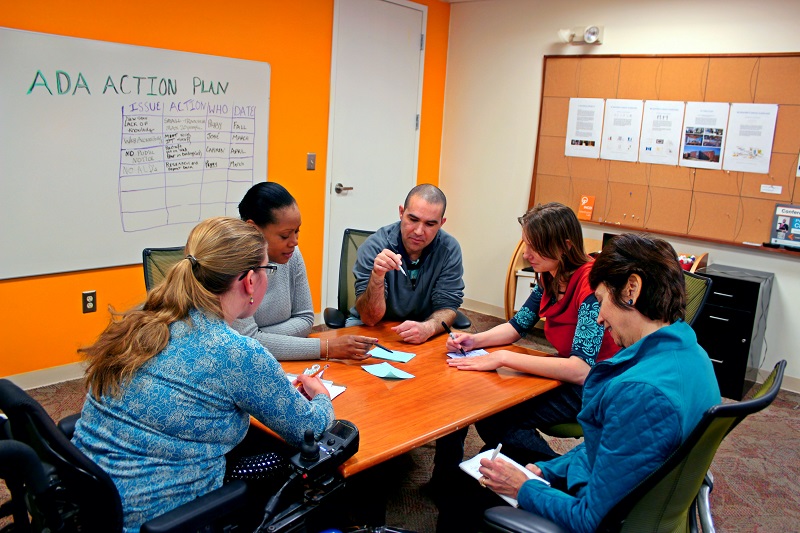Action Steps
Step 1 - Start Implementation
 Each public entity must formulate an approach that best suits itself and the community it serves. There is no one approach to compliance.
Each public entity must formulate an approach that best suits itself and the community it serves. There is no one approach to compliance.
Commitment by the public entity's senior political and executive leadership is essential and can be expressed in a variety of ways. A well-publicized public declaration of support or adoption of a formal policy statement can set a positive tone that facilitates staff involvement and promotes support and cooperation.
Most public entities start by appointing an ADA Coordinator and putting together an ADA team. Here are how two public entities, a state and a city, approached the self-evaluation and compliance process.
Examples of Implementation Methods
|
State of Rhode Island |
City of Austin, Texas |
|
|---|---|---|
|
ADA Coordinator |
Director, Governor’s Commission on Disabilities |
Staff member, Human Resources Department and Human Rights Commission |
|
ADA Team |
High-ranking representatives from all three branches of state government--executive, legislative, and judicial. |
Representatives from city departments and disability organizations in the community. |
|
ADA Self-Evaluation Process |
|
|
ADA Team
A team approach is key to achieving successful compliance for several reasons. First, the self-evaluation and transition plan require collecting information from all programs, services, and activities of the entity. This is too large a task for one person. Second, the transition plan and self-evaluation require varied expertise and specialized skills.
One of the important aspects of putting together a team is to identify the various players needed for this effort. The following criteria should be considered:
Representation of all departments
Each department or other major organizational unit should designate a liaison to participate in overall planning and decision making, collect information regarding his or her department's policies and practices, inform staff within the department of ADA requirements, and serve as contact person for the public within that department.
Special skills and expertise
Including staff and/or external parties with skills and expertise in the following areas will be very helpful to the team:
- finance and budgeting
- capital planning
- facilities management
- employment
- contracts and purchasing
- public works
- communication accessibility
Involvement of people with disabilities
There are several reasons to include people with disabilities. First, the regulation requires that public entities provide an opportunity for people with disabilities and other interested individuals or organizations to review and comment on the self-evaluation and transition plan. Second, involving the end users in the process will generate solutions that are creative and effective. Third, involving people with disabilities in decision-making will strengthen the accountability of the process and ensure wise use of limited public resources. The team should include representation of as wide a range of disabilities as possible. People with physical, visual, hearing, speech, intellectual, learning, behavioral health, and other disabilities may be included on the team.
ADA Training
Learning about the ADA, both the purpose and requirements, is critical. Participants should include staff, board members, committee chairs and others involved in running the public entity. Some public entities hold on-site trainings and invite the public. Here are a few training possibilities:
The ten ADA Centers and their state affiliates provide training on every aspect of the ADA.
Web-based, free, covers the basic principles and core concepts in the five titles of the ADA. A project of the ADA National Network and sponsored by the Southeast ADA Center.
Web-based, free, covers the basic principles and core concepts of title II. A project of the ADA National Network and sponsored by the Southeast ADA Center.
ADA Title I Employment Requirements
Web-based, free, covers title I employment. A project of the ADA National Network and sponsored by the New England ADA Center.
Annual Mid-Atlantic ADA Update Conference
The region's leading 3-day conference, featuring speakers from federal agencies such as the U.S. Departments of Justice and Transportation, Equal Employment Opportunity Commission, and the Access Board. Sponsored by the Mid-Atlantic ADA Center.
Four day event includes more than seventy breakout sessions on every aspect of the ADA. It is a project of the ADA National Network and is organized and run by the Great Plains ADA Center.
Next Steps
- Appoint an ADA Coordinator
- Provide Public Notice
- Adopt a Grievance Procedure
- Conduct a Self-Evaluation
- Develop a Transition Plan
- Create an Action Plan
Step 2 - Appoint an ADA Coordinator
 If a public entity has 50 or more employees, it is required to designate at least one responsible employee to coordinate ADA compliance. Although the law does not refer to this person as an “ADA Coordinator,” this term is commonly used. A public entity may have more than one ADA Coordinator. Most states and many counties and municipalities have an overall ADA Coordinator and also have ADA Coordinators at the agency and department level. Some public entities have an employee who oversees employment issues and another to coordinate the non-employment obligations.
If a public entity has 50 or more employees, it is required to designate at least one responsible employee to coordinate ADA compliance. Although the law does not refer to this person as an “ADA Coordinator,” this term is commonly used. A public entity may have more than one ADA Coordinator. Most states and many counties and municipalities have an overall ADA Coordinator and also have ADA Coordinators at the agency and department level. Some public entities have an employee who oversees employment issues and another to coordinate the non-employment obligations.
The ADA Coordinator is the key player in ensuring ADA compliance. The coordinator must have the authority, knowledge, and motivation to implement the regulations effectively.
One of the greatest benefits of having an ADA Coordinator is that the public can identify an employee to contact with their ADA questions or complaints. Having an ADA Coordinator benefits other employees by providing a specific person with knowledge and information about the ADA. And, of course, the person coordinates compliance efforts and is instrumental in ensuring that compliance plans move forward.
Coordinator's Role
- Plan and coordinate compliance efforts.
- Develop and distribute notice about ADA compliance.
- Respond to general inquiries from the public.
- Coordinate requests for auxiliary aids and services and reasonable modifications of policies, practices and procedures.
- Train staff, boards and commissions on ADA requirements.
- Interact and consult with staff, boards and commission on the ADA.
- Develop a grievance procedure.
- Investigate complaints.
- Conduct a self-evaluation.
- Develop a transition plan.
Qualifications
- Familiarity with the state or local government’s structure, activities, programs and employees.
- Knowledge of the ADA Experience with people with a broad range of disabilities.
- Knowledge of various alternative formats and alternative technologies that enable people with disabilities to communicate, participate, and perform tasks.
- Ability to work cooperatively with the public entity and people with disabilities.
- Negotiation and mediation skills.
- Organizational and analytical skills.
Examples of Involvement
- Meet with municipal recreation department staff when a new program is being created to ensure the participation of people with disabilities.
- Get involved in the discussion of the design of a new courthouse to make sure the ADA Standards are being followed.
- Work with a state agency that is developing a housing program to clarify that some of the units need to be mobility and communication accessible.
- Review draft of county department of mental health contract with private providers to check that ADA obligations are part of the contract.
To ensure that the public can easily identify the ADA Coordinator, the person’s name and contact information must be provided to the public. This can be done through Step 3 Provide Public Notice.
Step 3 - Provide Public Notice
 All public entities must provide information to the public, program participants, program beneficiaries, applicants and employees about the ADA and how it applies to the public entity. Here are some methods that public entities have used over the last 20 plus years.
All public entities must provide information to the public, program participants, program beneficiaries, applicants and employees about the ADA and how it applies to the public entity. Here are some methods that public entities have used over the last 20 plus years.
Methods
- Put the notice on the public entity’s website.
- Include the notice in social media such as Twitter and Facebook.
- Post the notice at facilities.
- Publish the notice in local newspapers.
- Broadcast the notice in public service announcements on local radio and television stations.
- Include the notice in program announcements and applications.
The information must be provided in “alternative” formats so that it is accessible to people with hearing and vision disabilities.
Examples of Alternative Formats
- Captioned public service announcements on television
- Large print (recommend: san-serif typeface such as Helvetica or Arial, 18 point size. If an individual requests a specific point size, provide notice in that size)
- Braille
- Text file on a thumb disk or emailed to the person
- HTML format on an accessible website
- Audio recording
- Radio announcement
Public entities must provide the information not just once, but on an ongoing basis. Changes should be made as necessary, for example when there’s a new ADA Coordinator.
Sample notice (long)
Americans with Disabilities Act
(Name of public entity) does not discriminate on the basis of disability in its services, programs, or activities.
Employment: (Name of public entity) does not discriminate on the basis of disability in its hiring or employment practices and complies with the ADA title I employment regulations.
Effective Communication: (Name of public entity) will, upon request, provide auxiliary aids and services leading to effective communication for people with disabilities, including qualified sign language interpreters, assistive listening devices, documents in Braille, and other ways of making communications accessible to people who have speech, hearing, or vision impairments.
Modifications to Policies and Procedures: (Name of public entity) will make reasonable modifications to policies and procedures to ensure that people with disabilities have an equal opportunity to enjoy programs, services, and activities. For example, people with service animals are welcomed in (name of public entity) offices, even where pets and other animals are prohibited.
Requests: To request an auxiliary aid or service for effective communication, or a modification of policies or procedures contact [ADA Coordinator name and contact information] as soon as possible, preferably XX days before the activity or event.
Complaints: Send complaints to [ADA Coordinator name and contact information].
Sample notice (short)
Americans with Disabilities Act
The [Name of public entity] does not discriminate on the basis of disability in its programs, services, activities and employment practices.
If you need auxiliary aids and services for effective communication (such as a sign language interpreter, an assistive listening device or print material in digital format) or a reasonable modification in programs, services or activities contact the ADA Coordinator as soon as possible, preferably XX days before the activity or event.
A grievance procedure is available to resolve complaints.
Upon request, this notice is available in alternative formats such as large print or Braille.
[ADA Coordinator name and contact information]
More on Notice
Public entities are required to ensure that interested people, including people with vision or hearing impairments, can obtain information as to the ”existence and location of accessible services, activities, and facilities.” This is an important but frequently overlooked part of the regulations.
Examples:
- County B’s recreation department has four playgrounds. Two were renovated using the ADA Standards for Accessible Design and are accessible to children and adults with disabilities, two are not accessible. County B has information on the website concerning which playgrounds are accessible and which aren’t. The information is also included in the recreation department’s brochure.
- State D’s museum has monthly tours that include sign language interpreters for people who are deaf. The museum will also try to get interpreters for any program with 14 days notice. This information is on the museum’s website, posted in the ticket purchase area and included in the museum’s brochure.
- A City Managers’ office receives a call from a new resident who uses a wheelchair. The resident would like to know which city facilities are accessible (and which aren’t) and where the accessible entrances are. The City Manager's administrative assistant can provide that information because the ADA Coordinator created a list of the accessibility features in all facilities. The list is on the city’s website and the ADA Coordinator sent an email to all staff with the link.
Step 4 - Adopt a Grievance Procedure
 Public entities with 50 or more employees must have a grievance procedure.
Public entities with 50 or more employees must have a grievance procedure.
A grievance procedure provides people who believe they have been discriminated against because of their disability, or others who believe they have been discriminated against because they have a friend or family member with a disability, with a formal process to make their complaint known. This procedure encourages prompt and equitable resolution of the problem at the local or state level without forcing people to file a federal complaint or a lawsuit.
The Title II regulations do not specify the procedures for the grievance procedure. The public entity may use a grievance procedure that is already in place; there is no need to reinvent the wheel or duplicate existing procedures. If the organization does not already have a grievance procedure, one must be established.
This Action Guide recommends that a grievance procedure include the following:
- A description of the procedures for submitting a grievance.
- The steps that will be taken by the public entity.
- Reasonable, specific time frames for review and resolution of the grievance.
- A two-step review process that allows for appeal.
- Record-keeping for complaints submitted.
- Documentation of steps taken towards resolution.
Below is a link to long and short sample grievance procedures.
Step 5 - Conduct a Self-Evaluation
 The self-evaluation is a comprehensive review of all programs, activities, and services operated by the public entity. The self-evaluation was required to be completed by January 26, 1993. Because changes were made to the Title II regulations and the ADA Standards for Accessible Design in 2010, an updated self-evaluation is recommended. The Title II regulations and ADA Standards were changed to include recreation areas from play areas to swimming pools, residential facilities, event ticketing policies, policies concerning other-power-driven mobility devices, miniature horses as service animals and specifications for video-remote-interpreting. Plus since information technology barely existed when the ADA was passed in 1990, and all state and local governments now have website that need to be accessible to people with disabilities, websites need to be evaluated.
The self-evaluation is a comprehensive review of all programs, activities, and services operated by the public entity. The self-evaluation was required to be completed by January 26, 1993. Because changes were made to the Title II regulations and the ADA Standards for Accessible Design in 2010, an updated self-evaluation is recommended. The Title II regulations and ADA Standards were changed to include recreation areas from play areas to swimming pools, residential facilities, event ticketing policies, policies concerning other-power-driven mobility devices, miniature horses as service animals and specifications for video-remote-interpreting. Plus since information technology barely existed when the ADA was passed in 1990, and all state and local governments now have website that need to be accessible to people with disabilities, websites need to be evaluated.
After conducting a self-evaluation, a public entity can develop a transition plan for structural changes and work with the public entity’s departments and agencies to modify policies and procedures.
Identify Departments and Programs
One way to make sure that the self-evaluation is comprehensive is to identify all of the public entity’s programs, services, and activities. A city or town may have twenty or more departments, including:
- Assessor
- Building
- City Clerk
- Council on Aging
- Fire
- Health
- Historical
- Hospital
- Human Resources
- Libraries
- Mayor's or Manager’s Office
- Parks and Recreation
- Police
- Planning
- Public Works
- Retirement
- School
- Treasurer
- Youth Services
- Veterans
- Voter Registrar
A state or county will probably have more agencies, offices and departments.
Within each department there may be many programs, services, and activities. A Council on Aging, for example, might provide meal programs, transportation programs, health services, recreational activities, and referral services. A state judiciary will have many courts and might provide other services such as mediation, divorce education, legal training and a court newsletter.
The evaluation can be done in at least four ways:
- By the ADA Coordinator
- By the ADA Coordinator and an ADA team
- By the ADA Coordinator and ADA liaisons for each department and agency
- By an outside consultant in collaboration with the ADA Coordinator
The size of the public entity and the budget will probably determine how the evaluation is conducted.
The self-evaluation should cover general nondiscrimination provisions, communications, program and facility accessibility and web accessibility.
To conduct a self-evaluation:
- Identify all programs, activities, and services and their locations.
- Determine whether employees and officials are familiar with the public entity’s ADA obligations, including the requirement to make reasonable modifications to policies, practices and procedures.
- Determine whether employees and officials know how to arrange for auxiliary aids and services, such as sign language interpreters, material in Braille and assistive listening systems; to ensure that communication with people with disabilities is as effective as others.
- Review service, activity and program’s policies and procedures to determine whether they ensure an equal opportunity for people with disabilities to participate and benefit.
- Survey facilities and determine whether there are physical barriers to access programs. If non-structural changes, such as moving programs, should be made, include them in the action plan. If structural changes are needed, include them in the transition plan.
The self-evaluation forms on this website are in fillable PDF, Word and text for Brailling.
Step 6 - Develop a Transition Plan
 The transition plan is developed from the self-evaluation and facilities survey. Public entities with 50 or more employees were required to develop a transition soon after the Title II regulations were issued. That is a long time ago. Many public entities are reassessing their facilities to determine if the original transition plan was followed and whether additional access improvements are needed.
The transition plan is developed from the self-evaluation and facilities survey. Public entities with 50 or more employees were required to develop a transition soon after the Title II regulations were issued. That is a long time ago. Many public entities are reassessing their facilities to determine if the original transition plan was followed and whether additional access improvements are needed.
Another reason to update or create a new transition plan is that the current (2010) ADA Standards for Accessible Design include accessibility requirements for recreation areas such as swimming pools, fishing piers, golf courses, play areas, recreational boating areas, exercise equipment rooms, team seating and locker rooms. The Standards also specify accessible routes to and between sports fields, for example baseball, soccer and football fields.
To assure equal opportunity and program accessibility, these recreation activities need to be surveyed using the current ADA Standards and many of the recreation areas will need to be updated in accordance with the ADA Standards.
A transition plan consists of:
- A list of the physical barriers that limit the accessibility of programs, activities, or services.
- The methods to remove the barriers and make the facilities accessible.
- The schedule to get the work completed.
- The name of the official(s) responsible for the plan's implementation.
Many public entities include cost estimates and which budget the funds will come from as part of their plan.
A transition plan must also include a schedule for providing curb ramps giving priority to walkways serving entities covered by the ADA, including state and local government offices and facilities, transportation, places of public accommodation, and employers, followed by walkways serving other areas.
Here is a sample transition plan plus columns for cost estimates and sources of funds.
City of XXX – ADA Transition Plan
City Hall
January 4, 2017
Prepared by: ADA Coordinator and Director of Facilities
|
Area |
Access Issue |
Solution |
Target Date |
Person Responsible |
Cost Estimate |
Source of Fund |
|---|---|---|---|---|---|---|
|
South Entrance ramp |
1:9 slope, cracks, square handrails |
New ramp |
6/15 |
Facilities manager |
$9,500 |
Capital budget |
|
North Entrance |
No sign indicating direction to accessible entrance |
Install sign |
2/4 |
Facilities manager |
$40 |
Maintenance and repairs |
|
First floor |
|
|
|
|
|
|
|
Single user toilet room |
No tactile sign |
Install sign |
2/4 |
Facilities Manager |
$40 |
Maintenance and repairs |
|
City clerk |
Counter at 44” |
Lower section to 36” max. high, 36” min. length. Short term: Provide clipboard at counter. |
6/1 |
Facilities Manager |
$450 |
Maintenance and repairs |
|
City Council room
|
Inadequate maneuvering clearance at entrance door |
Install automatic door opener |
6/1 |
Facilities Manager, outside contract |
$1,100 |
Capital budget |
|
City Council room
|
No assistive listening system |
Install FM system |
10/1 |
Audio Visual employee |
$2,200 |
A/V equipment fund |
Download your own Transition Plan form
Step 7 - Create an Action Plan
 After a self-evaluation there are many actions that need to be taken that don’t include structural changes to buildings. The public entity's website might need to be reviewed for accessibility, policies might need to change and meetings might need to be moved. The Title II regulations don’t include a planning process for these non-structural tasks. The regulations state: “to the extent modification of … services, policies, and practices is required, the public entity shall proceed to make the necessary modifications.”
After a self-evaluation there are many actions that need to be taken that don’t include structural changes to buildings. The public entity's website might need to be reviewed for accessibility, policies might need to change and meetings might need to be moved. The Title II regulations don’t include a planning process for these non-structural tasks. The regulations state: “to the extent modification of … services, policies, and practices is required, the public entity shall proceed to make the necessary modifications.”
The transition plan addresses all things structural, but there’s no formal planning mechanism to make sure the non-structural changes are made. This Guide recommends that public entities develop Action Plans to address these non-structural issues.
The following is a sample Action Plan that can be used as a model by public entities. Include any other columns that would be helpful.
Sample Action Plan
|
Problem |
Solutions |
Target Date |
Person Responsible |
Comments |
|---|---|---|---|---|
|
|
4/15 and ongoing |
ADA Coordinator |
Neighboring municipalities have samples and recommended methods. |
|
|
3/2 |
Administrative Assistant |
|
|
|
5/2 |
IT staff |
Confer with Disability Commission to find user/experts to conduct testing. |
|
|
6/15 and ongoing |
ADA Coordinator and Disability Commission Members |
Provide snacks. |
|
|
3/15 and ongoing |
ADA Coordinator |
Provide snacks. |
|
|
5/10 |
ADA Coordinator |
|
Download your own Action Plan form



